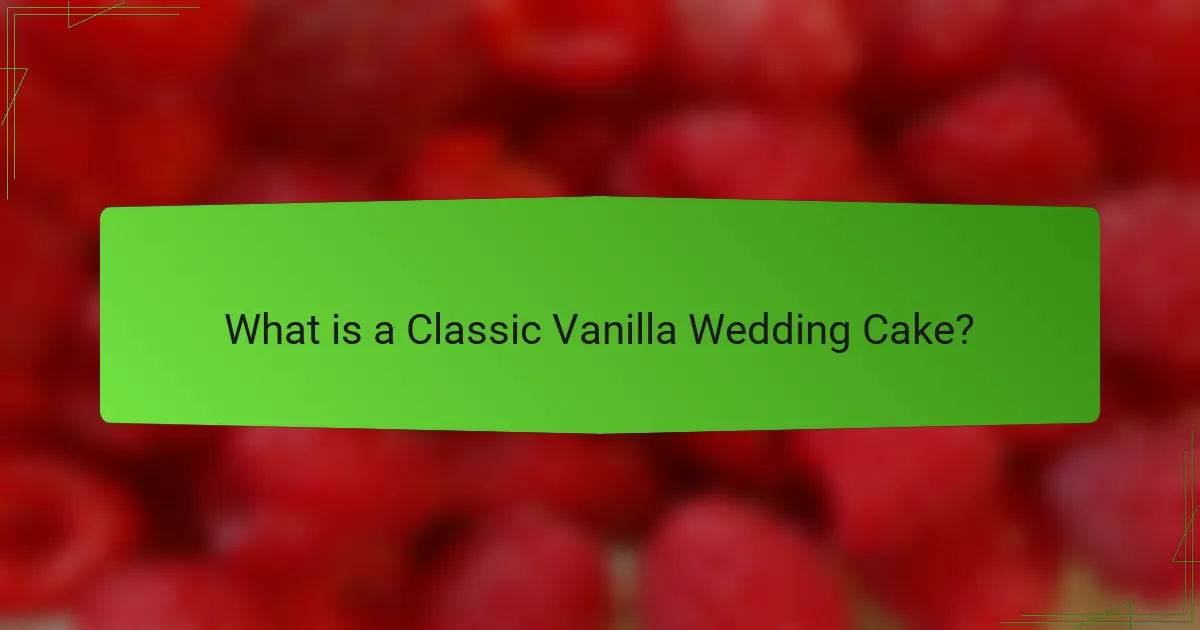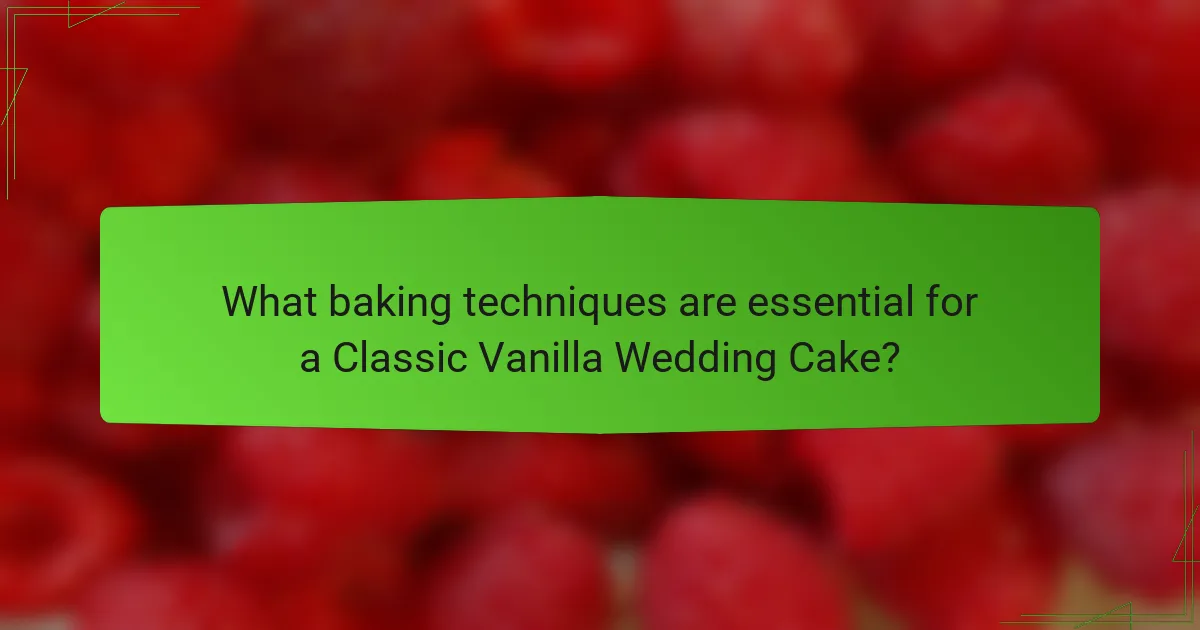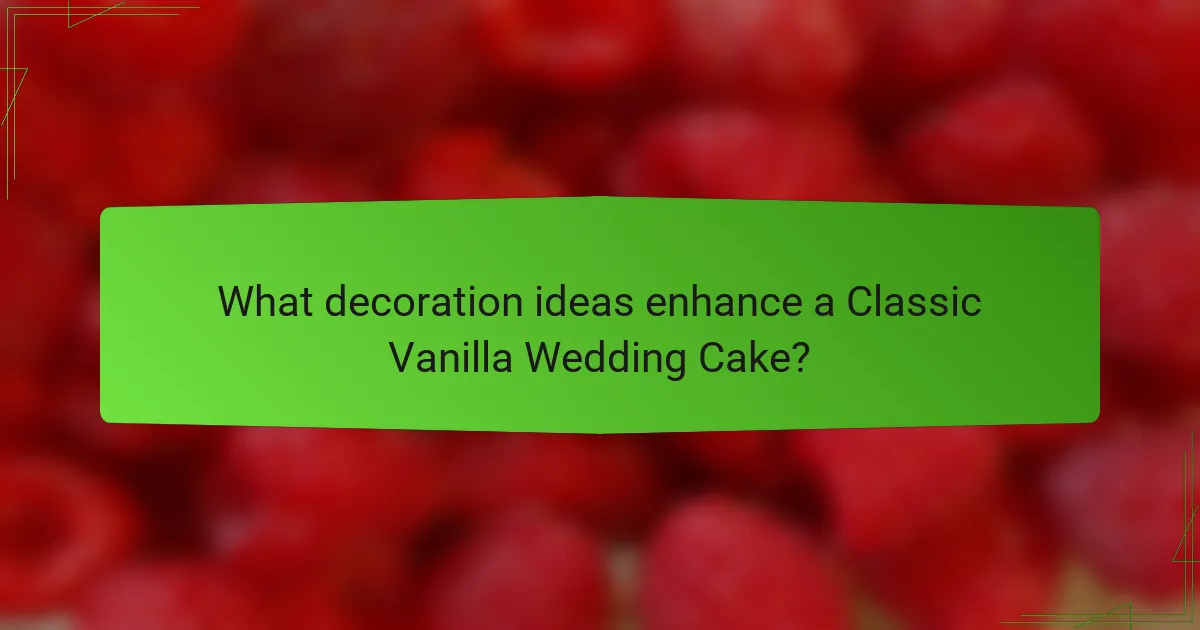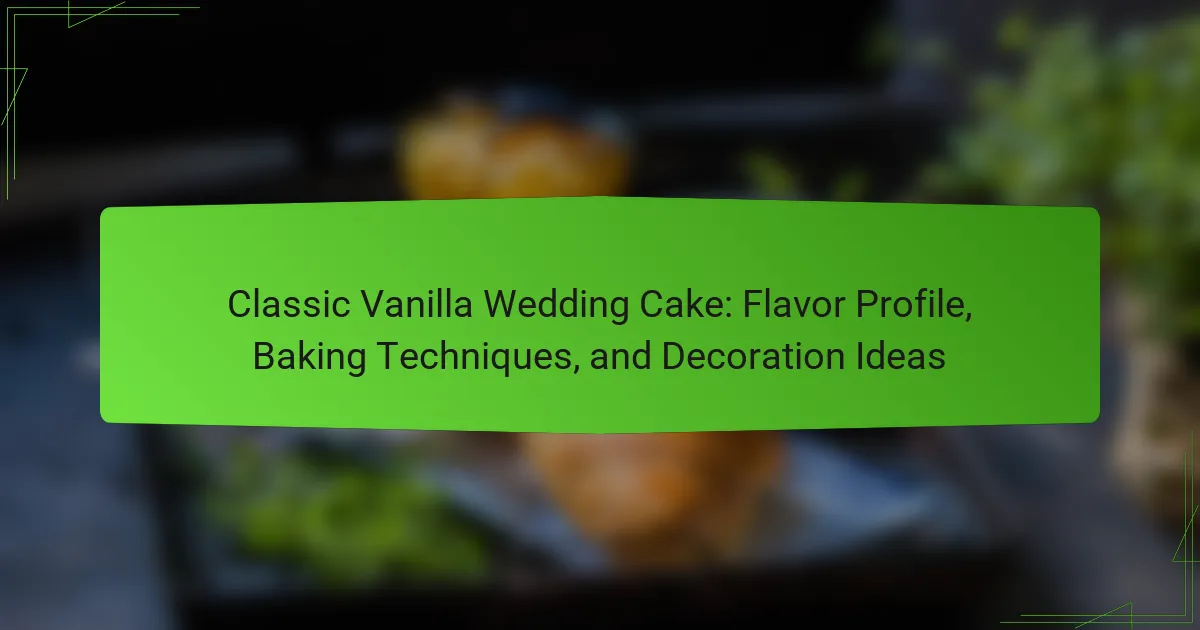
What is a Classic Vanilla Wedding Cake?
A Classic Vanilla Wedding Cake is a traditional dessert served at weddings. It typically features a light and fluffy vanilla-flavored sponge or butter cake. The cake is often layered with vanilla buttercream or cream cheese frosting. This type of cake is known for its simple yet elegant flavor profile. Vanilla extract is commonly used to enhance its taste. Classic vanilla wedding cakes can be decorated with fresh flowers or intricate fondant designs. They are popular for their versatility and ability to complement various wedding themes. Historically, vanilla cakes have been a staple in wedding celebrations for centuries.
How does the flavor profile of a Classic Vanilla Wedding Cake develop?
The flavor profile of a Classic Vanilla Wedding Cake develops through the combination of key ingredients and baking techniques. The primary ingredient, vanilla extract, provides the signature flavor. High-quality vanilla enhances the cake’s aromatic qualities. Sugar contributes sweetness, balancing the vanilla’s intensity. Butter adds richness and a creamy texture, which deepens the flavor. Eggs provide structure and moisture, enriching the overall taste.
The cake’s flavor evolves during the baking process. The Maillard reaction occurs, creating complex flavors as the cake browns. Cooling allows the flavors to meld, resulting in a more harmonious taste. Additionally, frosting, often made with butter and vanilla, complements the cake’s flavor, enhancing the overall experience.
The balance of these elements is crucial for a well-rounded flavor profile. Each component plays a vital role in developing the classic taste associated with wedding cakes.
What ingredients contribute to the flavor of a Classic Vanilla Wedding Cake?
The ingredients that contribute to the flavor of a Classic Vanilla Wedding Cake include vanilla extract, butter, sugar, and eggs. Vanilla extract provides the primary flavor profile, delivering a sweet and aromatic essence. Butter adds richness and depth to the cake’s taste. Sugar enhances sweetness, balancing the flavors. Eggs contribute moisture and structure, impacting texture and taste. Together, these ingredients create a harmonious and classic vanilla flavor that is cherished in wedding cakes.
How does the choice of vanilla affect the cake’s taste?
The choice of vanilla significantly impacts a cake’s taste. Different types of vanilla, such as Madagascar, Tahitian, and Mexican, each bring unique flavor profiles. Madagascar vanilla has a rich, creamy flavor that enhances sweetness. Tahitian vanilla offers floral and fruity notes, adding complexity to the cake’s taste. Mexican vanilla has a bold, spiced flavor that can create a more robust taste. The quality of vanilla also matters; pure vanilla extract delivers a more intense flavor compared to imitation vanilla. Using high-quality vanilla can elevate the overall cake experience.
What are the traditional characteristics of a Classic Vanilla Wedding Cake?
A Classic Vanilla Wedding Cake is traditionally characterized by its light, fluffy texture and rich vanilla flavor. The cake is typically made with simple ingredients such as flour, sugar, eggs, butter, and vanilla extract. It often features a smooth buttercream frosting that complements the cake’s flavor. The cake is usually layered, providing a visually appealing structure. Decorations are often elegant and minimalistic, aligning with traditional wedding aesthetics. Classic Vanilla Wedding Cakes are often adorned with fresh flowers or simple piping designs. This cake serves as a symbol of celebration and is a staple at many weddings. Its timeless appeal makes it a preferred choice for couples.
How does texture play a role in the overall experience of the cake?
Texture significantly influences the overall experience of the cake. It affects mouthfeel, which is crucial for enjoyment. A cake’s texture can range from light and airy to dense and moist. Each texture contributes differently to the flavor perception. For example, a fluffy cake enhances the sweetness, while a denser cake may provide a richer taste. Texture also affects how the cake interacts with other elements, such as frosting or fillings. A smooth texture can create a pleasing contrast with crunchy toppings. Additionally, texture impacts the cake’s visual appeal, as different textures can make the cake more enticing. Overall, texture is a key component that enhances the sensory experience of enjoying a cake.
What is the significance of the cake’s appearance in weddings?
The appearance of the cake in weddings symbolizes celebration and unity. A wedding cake serves as a focal point during the reception. Its design reflects the couple’s personal style and theme. Traditionally, multi-tiered cakes represent prosperity and good fortune. The decoration often includes elements like flowers or intricate designs. These elements enhance the visual appeal and create a memorable experience. The cake cutting ceremony signifies the couple’s first act together as a married couple. This ritual reinforces the bond and shared commitment between partners.

What baking techniques are essential for a Classic Vanilla Wedding Cake?
Essential baking techniques for a Classic Vanilla Wedding Cake include proper creaming, accurate measuring, and careful folding. Creaming butter and sugar aerates the mixture, creating a light texture. Accurate measuring of ingredients ensures the right balance for the cake structure. Folding in dry ingredients gently preserves the aeration achieved during creaming. Additionally, using room temperature ingredients promotes even mixing and incorporation. Baking at the correct temperature is crucial for even rising and browning. Finally, allowing the cake to cool completely before frosting prevents melting and sliding of decorations. These techniques are fundamental for achieving a successful Classic Vanilla Wedding Cake.
How do different mixing methods impact the cake’s outcome?
Different mixing methods significantly impact a cake’s outcome. The creaming method incorporates air into the batter, resulting in a light and fluffy texture. This method is ideal for cakes like the classic vanilla wedding cake. The reverse creaming method, where fat is mixed with dry ingredients before adding liquids, produces a denser crumb. This technique can lead to a moist cake with a fine texture. The all-in-one method combines all ingredients at once, often resulting in a quicker but less aerated cake. Each method affects the cake’s rise, texture, and moisture content. For instance, cakes made with the creaming method typically have a higher volume compared to those made using the all-in-one method.
What are the steps involved in the creaming method?
The creaming method involves several key steps. First, cream together softened butter and sugar until light and fluffy. This process incorporates air, which helps the cake rise. Next, add eggs one at a time, mixing well after each addition. This ensures even distribution and emulsification. Then, gradually mix in dry ingredients, alternating with liquid, starting and ending with the dry ingredients. This method helps maintain the batter’s structure. Finally, pour the batter into prepared pans and bake until a toothpick inserted comes out clean. Each step is crucial for achieving a light and tender cake texture.
How does the folding technique affect the cake’s lightness?
The folding technique significantly enhances a cake’s lightness. This method incorporates air into the batter, which is essential for a fluffy texture. When ingredients like whipped egg whites are folded into the batter, they maintain their volume. This retained air contributes to the cake’s rise during baking.
Research shows that proper folding can increase the cake’s volume by up to 20%. The gentle motion prevents the air bubbles from breaking, ensuring a light and airy structure. A cake made with the folding technique will have a softer crumb compared to one made with vigorous mixing. Thus, the folding technique is crucial for achieving a light and delicate cake.
What baking temperatures and times should be used for optimal results?
For optimal results when baking a classic vanilla wedding cake, the recommended temperature is 350°F (175°C). At this temperature, cakes typically bake for 25 to 30 minutes. It’s essential to check for doneness by inserting a toothpick into the center. If it comes out clean, the cake is ready. Baking at 350°F allows for even cooking and proper rise. This temperature is widely used in baking and is considered standard for cakes. Following these guidelines ensures a moist and fluffy cake texture.
How can you determine when the cake is perfectly baked?
A cake is perfectly baked when a toothpick inserted in the center comes out clean. This indicates that the batter has set completely. Additionally, the edges of the cake should pull away slightly from the pan. The top should be golden brown and spring back when lightly pressed. The internal temperature of a fully baked cake is typically around 200°F (93°C). Checking these factors ensures the cake is not undercooked or overbaked.
What are common pitfalls to avoid during baking?
Common pitfalls to avoid during baking include improper ingredient measurements, incorrect oven temperatures, and neglecting to preheat the oven. Accurate measurements are crucial for achieving the right texture and flavor. Using a kitchen scale can help ensure precision. Baking at the wrong temperature can lead to uneven cooking or burnt edges. Always use an oven thermometer to verify the actual temperature. Preheating the oven is essential for consistent results. Skipping this step can affect rising and texture. Additionally, overmixing batter can result in a dense cake. Mixing just until combined maintains a light and airy structure. Lastly, not allowing the cake to cool properly before decorating can lead to a messy presentation. Following these guidelines will improve baking outcomes significantly.

What decoration ideas enhance a Classic Vanilla Wedding Cake?
Fresh flowers enhance a Classic Vanilla Wedding Cake beautifully. They add a natural and elegant touch. Edible flowers like roses or peonies are popular choices. Sugar flowers can also be crafted for a more intricate design. Fruit toppings, such as berries, provide color and freshness. A drizzle of chocolate or caramel sauce adds richness. Decorative piping with buttercream creates texture and detail. Finally, gold or silver leaf can add a luxurious finish. Each of these decoration ideas complements the cake’s classic flavor profile.
How can frosting choices influence the cake’s presentation?
Frosting choices significantly influence a cake’s presentation. The color and texture of frosting can enhance visual appeal. For example, smooth buttercream creates a classic look. In contrast, textured frosting adds depth and interest. Flavor variations in frosting can also affect overall aesthetics. A chocolate ganache can add richness, while a fruit glaze offers a fresh appearance. Additionally, the application technique matters. Piping intricate designs or using fondant can elevate a cake’s elegance. Ultimately, the chosen frosting sets the tone for the entire cake presentation.
What types of frosting pair best with a Classic Vanilla Wedding Cake?
Buttercream frosting pairs best with a Classic Vanilla Wedding Cake. Its creamy texture complements the light flavor of vanilla. Cream cheese frosting is another excellent choice. It adds a slight tanginess that balances the sweetness. Fondant provides a smooth finish and is ideal for intricate designs. Whipped cream frosting offers a light and airy option. This enhances the cake’s delicate flavor without overwhelming it. Each frosting type enhances the overall experience while maintaining the cake’s classic appeal.
How can flavor-infused frostings elevate the cake experience?
Flavor-infused frostings enhance the cake experience by adding unique tastes and aromas. These frostings can complement the cake’s flavor profile. For example, a vanilla cake paired with lemon-infused frosting creates a refreshing contrast. Additionally, flavor-infused frostings can introduce unexpected elements, such as a hint of spice or fruitiness. This variety can make each bite more exciting and memorable. Studies show that flavor combinations can increase enjoyment and satisfaction in desserts. Flavor-infused frostings also contribute to visual appeal, making cakes more enticing. Overall, they transform a simple cake into a gourmet experience.
What are some popular decoration styles for wedding cakes?
Popular decoration styles for wedding cakes include fondant, buttercream, and [censured] cakes. Fondant provides a smooth, polished finish and can be shaped into intricate designs. Buttercream is versatile and can be piped into various patterns and textures. [censured] cakes feature minimal frosting, showcasing the cake layers and fillings. Other styles include floral decorations, using fresh or sugar flowers for an elegant touch. Geode cakes incorporate edible crystals for a unique look. Drip cakes have a glossy ganache cascading down the sides. Each style offers distinct visual appeal and can be customized to fit the wedding theme.
How can fresh flowers be incorporated into the cake design?
Fresh flowers can be incorporated into cake design by using them as decorative elements. They can be placed on top of the cake for a focal point. Flowers can also be arranged around the base for added elegance. Edible flowers are a safe option and enhance flavor. Ensure flowers are pesticide-free to avoid contamination. Use floral tape or picks to secure them in place. Popular choices include roses, peonies, and lavender. Fresh flowers add a natural and romantic touch to wedding cakes.
What are the benefits of using edible gold or silver leaf in decoration?
Edible gold or silver leaf enhances decoration by adding luxury and visual appeal. This metallic leaf is safe for consumption and creates an elegant touch to desserts. It reflects light, making cakes appear more vibrant and eye-catching. Edible gold has been used for centuries in gourmet cuisine, symbolizing wealth and opulence. Silver leaf, while less common, also conveys sophistication. Both types of leaf can elevate the presentation of a classic vanilla wedding cake. They can be applied easily and complement various flavors. The use of edible gold or silver leaf can impress guests and add a memorable element to celebrations.
What tips can help ensure a successful Classic Vanilla Wedding Cake?
To ensure a successful Classic Vanilla Wedding Cake, use high-quality ingredients. Fresh vanilla beans or pure vanilla extract enhance flavor significantly. Measure ingredients accurately for the right texture. Room temperature eggs and butter create a smoother batter. Bake at the correct temperature for even cooking. Use the toothpick test to check doneness; it should come out clean. Allow the cake to cool completely before frosting. This prevents melting and sliding of the icing. Properly level the cake layers for a stable stack.
How can you troubleshoot common baking issues?
To troubleshoot common baking issues, first identify the specific problem. For instance, if a cake is sinking, ensure that the oven temperature is accurate. Use an oven thermometer to verify the heat. If the cake is dry, check the flour measurement and avoid overmixing the batter. Excessive mixing can lead to a dense texture. If the cake is too dense, consider the freshness of the baking powder or baking soda. These leavening agents should be within their expiration date. If the cake has uneven baking, rotate the pan halfway through the baking time. This promotes even heat distribution. For burnt edges, lower the oven temperature and use a light-colored pan. This can prevent over-browning. Lastly, if the cake sticks to the pan, ensure proper greasing or lining with parchment paper. Following these troubleshooting steps can lead to better baking outcomes.
What best practices should be followed for decoration and presentation?
Best practices for decoration and presentation of a classic vanilla wedding cake include maintaining a clean and smooth surface. Use a bench scraper for even frosting application. Incorporate fresh flowers or seasonal fruits to enhance visual appeal. Choose a color palette that complements the wedding theme. Ensure decorations are securely placed to avoid shifting. Utilize cake stands to elevate the cake, adding elegance. Finally, consider lighting when displaying the cake to highlight its features. These practices ensure an aesthetically pleasing presentation that aligns with wedding standards.
Classic Vanilla Wedding Cake is a traditional dessert characterized by its light and fluffy texture, rich vanilla flavor, and elegant appearance. This article explores the flavor profile development through key ingredients like vanilla extract, butter, sugar, and eggs, as well as essential baking techniques such as the creaming method and proper temperature control. Additionally, it highlights popular decoration ideas, including fresh flowers and edible gold leaf, while providing best practices for successful baking and presentation. The comprehensive overview ensures readers understand the essential aspects of creating and decorating a Classic Vanilla Wedding Cake.
